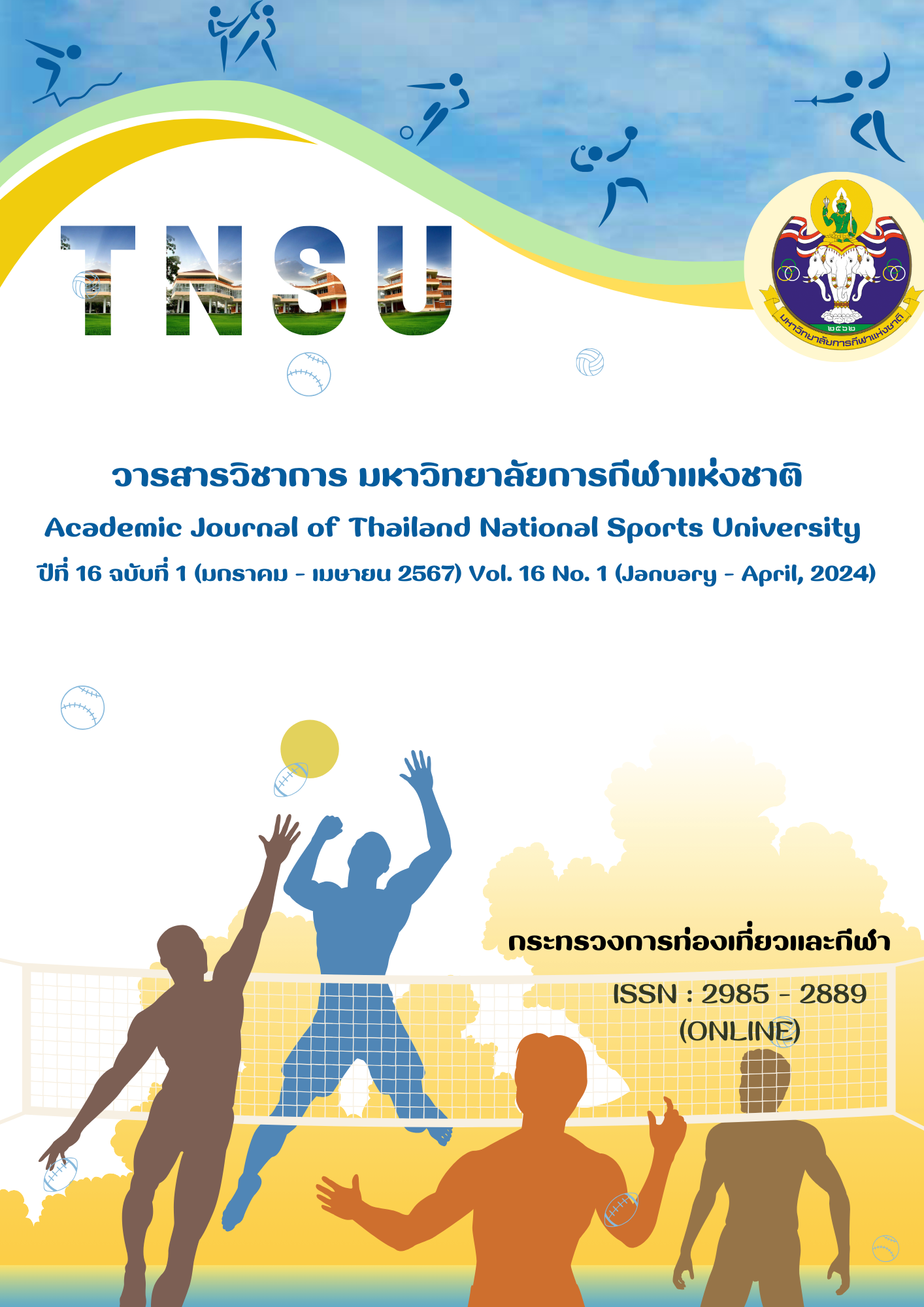ANALYSIS OF MUAY THAI IN THE LITERATURE OF RAMAYANA
Main Article Content
Abstract
This research aimed to analyze the names of movements, origins, and characteristics of performing Thai boxing movements in the literature of Ramayana. The main informants in this research were following; three experts in Ramayana and seven experts in Muaythai. The informants were selected by purposive sampling. The research instrument used was an structured interview. Analyze data with content analysis.
The analysis results are as follows:
- The results of the analysis of 59 Thai boxing stance names in the literature of Ramayana indicated that a total of names are associated with the literature of Ramayana. It is divided into 21 stances for Muay Ling, 11 stances for Muay Yak, 22 stances for Muay Pra, 2 stances for Muay Nang, and 3 names of animal stances in the literature of Ramayana.
- The results of the analysis of the performance characteristics of Thai boxing stances in the literature of Ramayana, a total of 59 stances, showed that some Thai boxing stances came from characters' behaviors and various events in the story that occurred in all Ramayana literature. The influence of the Ramayana literature has blended with the weaponry of Thai boxing stances, thus causing the connection between Thai boxing and Thai literature.
- The results of the analysis of the performance characteristics of Thai boxing stances in the Ramayana, a total of 59 stances, showed that the performance characteristics of the Thai boxing stances were appropriately linked with the names of the stances and the source of the Ramayana. Because Thai boxing is a martial art that outsmarts the opponent's action as effectively as possible, the characteristics of the Thai boxing stances in the Ramayana originated from the characters' natural behavior, the way they used weapons, and their manner combined with the stances of Thai boxing. Therefore, the performance characteristics of the Thai boxing stances appeared. This research has identified the performance characteristics of each Thai boxing stance.
Article Details

This work is licensed under a Creative Commons Attribution-NonCommercial-NoDerivatives 4.0 International License.
The published article is a copyright of the Academic Journal of Thailand National Sports University. The passage appeared in each article in this academic journal is a perspective of each author which is not related to the journal. Each author is required to be responsible for all components of his/her own article. If there are any mistakes, each author must be responsible for those mistakes on his/her own.
References
Attanich Phokasub. (2009). Geography and philosophy of Muay Thai Magic Muay Thai. Nonthaburi: P. Watin Publication.
Chanathep Wasavanon. (2012). Muay Thai Rattanakosin: Science and martial arts. Bangkok: Chulalongkorn University.
Charasdej Ulit, Sawang Wittayapitak, Sanong Sangsuk, Sorn Sukpimai, Pattana Boonwong, & Thani Homchampa. (2013). Knowledge management of Muay Thai 5 lines. Bangkok: Department of Cultural Promotion Ministry of Culture.
Jatuchai Champahom. (2009, February, 7). Special lecturer, Faculty of Sports Science. Burapha University. [Interview].
Kru Laem., Kru Pong., & Kru Dum. (2015). Scripture Muay Chaiya rope punch art. Bangkok: S. Asia Press.
Piyalak Upanisakorn. (2006). A study of the names of muay thai postures according to ethnic semantics (Master’s thesis), Chulalongkorn University.
Pornwin Chunkesa, Niwat Sukprasert, & Akakwit Ruangrong. (2022), Hanuman battle stance Matchanu in a song from the Rama I royal poem. Humanities Journal and social sciences Bansomdejchaopraya Rajabhat University, 16, 1 - 2, Retrieved from
https://so08.tcithaijo.org/index.php/jhusocbru/article/view/447
Prinnit Phokasub, & Attanich Phokasub. (2003). Muay Thai. Bangkok: A.P. Graph Fixed Design.
Prinnit Phokasub. (2003). Muay Thai. Bangkok: Mac.
Saithip Nukulkit. (1990). Literature review supporting documents for teaching Thai subjects. Bangkok: Srinakharinwirot University, Bangkhen.
Somporn Sangchai. (2012). Muay Phraya Phichai Dap Hak The successor of Yuttasilp, Tha Sao boxing office. Bangkok: Tipnet.
Vanisa Buayam. (2013). Study the concept of Ramayana character talisman. Department of Art History Faculty of Archeology, Silpakorn University. Retrieved from https://www.chennaimuseum.org/draft/gallery/03/01/012/tanjore5.html
Wanlop, B., Chanai, W., & Niwat, S. (2016) Ravana's role: A case study dance postures and khon performance tactics the story of ramakien when thao maliowarat said according to guidelines of Mr. Jatuporn Rattanawaraha. Academic Journal, 9, 1107 - 1108. Retrieved from https://he02.tci-thaijo.org/index.php/Veridian-E-Journal/article/ view/66992/54704
Wisarut Assasri. (2022). The principle of using the weapons of the protagonist in the Khon performance of the Ramayana story. Journal Humanities and Social Sciences University of Phayao, 8(1).


